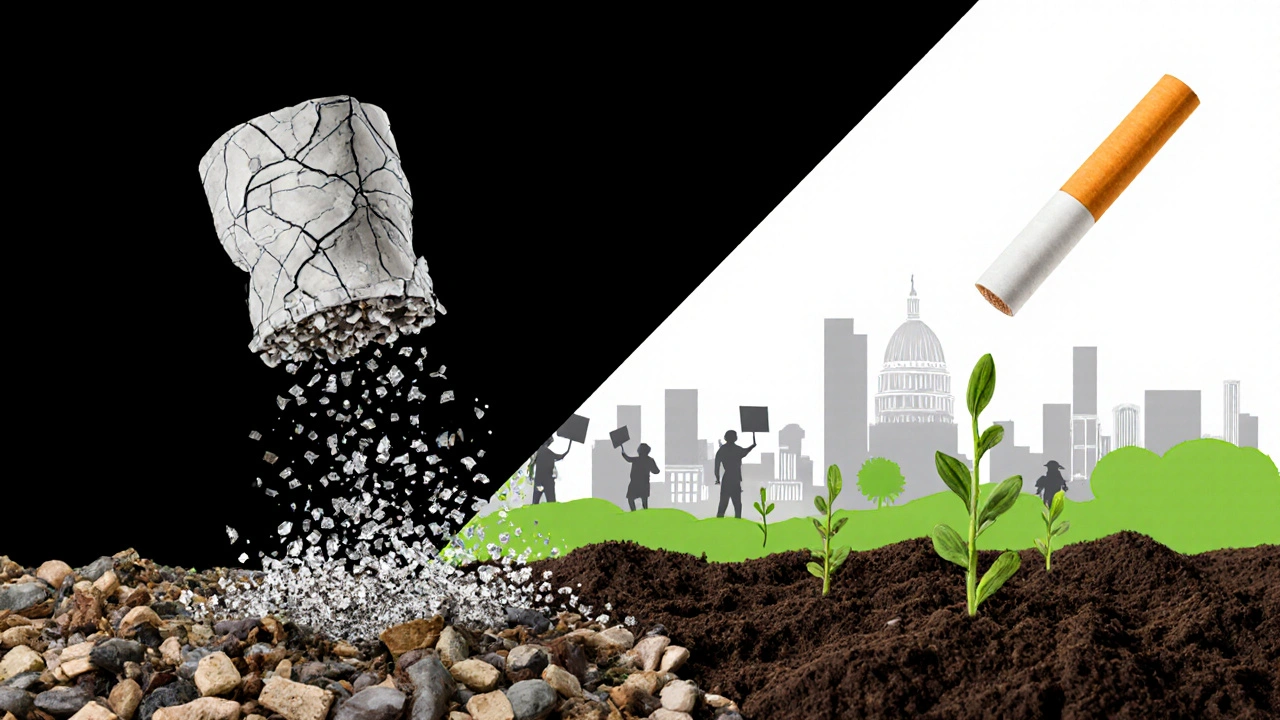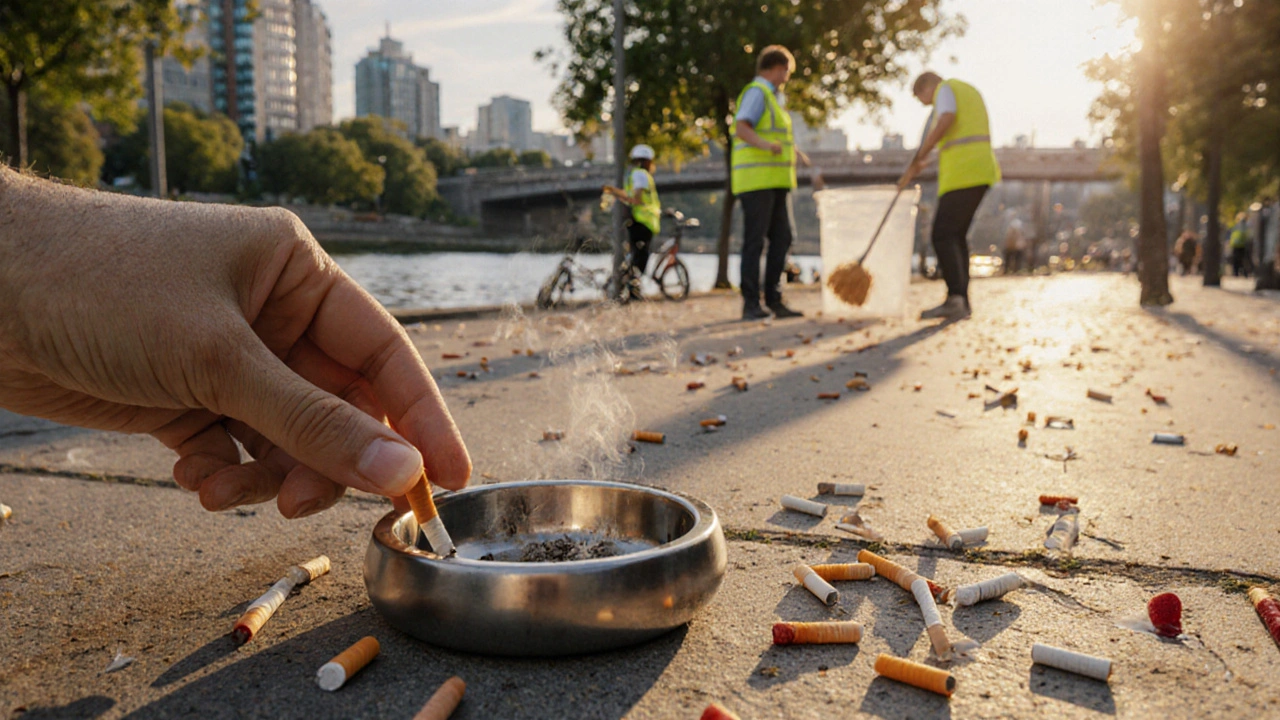Cigarette Waste Impact Calculator
Every year, billions of cigarette butts end up scattered across streets, beaches, and forests, turning a personal habit into a planetary problem. While the health risks of smoking are well‑known, the hidden toll of cigarette waste on ecosystems, water sources, and climate often flies under the radar. This article breaks down exactly how those tiny filters damage the planet and outlines practical steps you can take to curb the fallout.
What Makes a Cigarette Butt More Than Just a Tiny Tip?
Cigarette waste is a combination of a paper tube, tobacco remnants, and a cellulose acetate filter. The filter, commonly known as a cigarette filter, is a plastic‑based component designed to trap tar and nicotine, makes up about 85% of the butt’s weight. Because it doesn’t decompose like natural fibers, the filter lingers for years, slowly releasing chemicals into soil and water.
Chemical Cocktail Leaking From a Butt
The tobacco left in the butt continues to leach heavy metals (lead, cadmium), nicotine, and carcinogenic compounds such as benzo[a]pyrene. Studies by the U.S. Environmental Protection Agency show that a single butt can release up to 1,000 toxic substances into a single liter of water. When rain washes these chemicals into rivers, they become part of the plastic pollution problem that plagues fresh and marine habitats.
Marine Life Pays the Price
Marine animals mistake butts for food. Sea turtles, seabirds, and fish often ingest the plastic filter, leading to blockages, starvation, or toxic exposure. In the Pacific Ocean, researchers have documented that cigarette butts constitute roughly 0.5% of all visible litter, yet they account for a disproportionate share of wildlife injuries because of their appealing shape and size.

Landfills and Microplastics: A Long‑Term Legacy
When discarded butts end up in landfills, the cellulose acetate filter fragments into micro‑plastics that can travel with leachate into groundwater. A 2023 analysis of Australian landfill sites found that cigarette waste contributed to 2-3% of the total micro‑plastic load, enough to affect soil health and crop yields in surrounding farms.
The Economic Toll of Clean‑up
Municipalities spend billions annually on litter collection, and cigarette waste is a large slice of that pie. In Melbourne alone, the city council reported a $12million expense in 2022 for cleaning streets and parks contaminated by tobacco litter. The cost climbs when you factor in lost tourism revenue-beaches littered with butts deter visitors and damage local businesses.
Policy Moves That Are Making a Difference
Several governments have taken steps to curb cigarette litter:
- Australia introduced the National Tobacco Litter Strategy (2021), which funds community clean‑ups and mandates anti‑litter campaigns on cigarette packs.
- EU nations are testing extended producer responsibility (EPR) schemes that require tobacco companies to finance collection and recycling of filters.
- Some U.S. cities have enacted fines for littering cigarettes, aiming to deter careless disposal.
These policies hinge on one idea: make the tobacco industry accountable for the waste its product generates.

Biodegradable Alternatives: Hope on the Horizon
Researchers are developing filters made from plant‑based fibers, dissolvable polymers, or even edible materials. A head‑to‑head comparison of traditional cellulose acetate filters versus emerging biodegradable filters highlights key differences:
| Attribute | Cellulose Acetate (Standard) | Biodegradable Alternative |
|---|---|---|
| Material | Plastic‑based cellulose acetate | Plant fibers, polylactic acid (PLA) |
| Decomposition time | 5‑10 years (partial) | 3‑6 months under compost conditions |
| Toxic leachate | High; releases heavy metals & nicotine | Low; minimal chemical release |
| Impact on taste | Neutral (standardized) | Comparable; some brands report slight flavor difference |
| Cost per pack | Baseline | ~10‑15% higher (production scale dependent) |
While price remains a barrier, several premium brands already ship biodegradable filters in Europe, showing that consumer demand can drive market change.
What You Can Do Right Now
- Don’t litter: Use ashtrays, portable containers, or designated smoking zones.
- Pick up butts: Carry a small, reusable bag or a pocket‑sized butt picker on walks.
- Choose greener products: Opt for cigarettes with biodegradable filters or switch to vaping devices that produce less solid waste (though consider their own environmental footprint).
- Advocate locally: Support city ordinances that fund litter clean‑ups or impose producer responsibility fees.
- Educate peers: Share facts about tobacco litter in schools or community groups.
Quick Takeaways
- Cigarette butts are the most common litter item worldwide, with an estimated 4.5trillion discarded each year.
- The plastic filter releases toxic chemicals that harm water quality and wildlife.
- Landfill leachate turns butts into micro‑plastics that linger for decades.
- Policy measures and biodegradable filters can dramatically cut the environmental toll.
- Individual actions-proper disposal, clean‑up participation, and product choices-make a measurable difference.
Frequently Asked Questions
How long does a regular cigarette filter take to decompose?
Under typical outdoor conditions, a cellulose acetate filter can persist for 5‑10 years, breaking down only partially and leaving behind micro‑plastic fragments.
Are biodegradable cigarette filters widely available?
They are gaining traction in Europe and parts of North America, often marketed as “eco‑friendly” or “green” brands. Availability is still limited, but a few major manufacturers have announced rollout plans for 2025‑2026.
What chemicals leach from cigarette butts into water?
Heavy metals (lead, cadmium), nicotine, phenol, and polycyclic aromatic hydrocarbons (PAHs) such as benzo[a]pyrene are among the most harmful substances released.
How much does cleaning cigarette litter cost cities?
Australian municipal reports estimate annual clean‑up expenses of $10‑15million for major cities, with tobacco litter accounting for up to 15% of total litter removal costs.
Can I recycle cigarette butts?
Some pilot programs in the UK and Japan collect used butts for conversion into industrial oil or carbon‑rich material, but widespread recycling is still limited. Proper disposal in a sealed container until a collection service is available is the safest interim method.


Hi, I'm Caden Lockhart, a pharmaceutical expert with years of experience in the industry. My passion lies in researching and developing new medications, as well as educating others about their proper use and potential side effects. I enjoy writing articles on various diseases, health supplements, and the latest treatment options available. In my free time, I love going on hikes, perusing scientific journals, and capturing the world through my lens. Through my work, I strive to make a positive impact on patients' lives and contribute to the advancement of medical science.